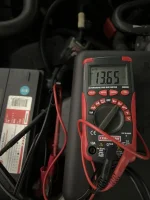When I spoke to an odyssey engineer a while back he was adamant that if the long term float voltage applied from a float or maintenance charger was not 13.6v, at 77f, then it should not be floated long term. Lots of so called 'maintenance' charger will float at 13.2, even on the AGM setting. Floating at too low a voltage for a long time is not a good thing, but especially when there is a significant parasitic load on the DC system.
Floating too high a voltage is overcharging and causes positive plate degradation and flooded batteries will use a lot more water.
On my own system:
If I float my Northstar at 13.6v exactly in the 70f temp range, then crank voltage to 14.8, amps quickly taper to 0.5 or less, usually much less, indicating this float voltage kept the battery truly fully charged.
If I float it at 13.5v in the same temp range, for a day or 2, then crank voltage upto 14.8v, amps will go up above 5 and over 25 minutes taper to the 0.5 range and take another half hour to taper to 0.2. This indicates the 0.1v float voltage difference, allowed the battery to discharge slightly, also proving just how important the float voltage be right for the specific battery.
Note than some AGMs say 13.2 to 13.4 float, others are 13.6 and I think I even saw one was 13.8v all at 77f/25c degrees.
So even if a smart charger has a specific setting for AGM, if the float voltage it holds is too low, the battery can very slowly discharge, even if this float voltage is well above its natural full charge open circuit resting voltage, which on a Northstar is 13.06 in my experience, My Dekas AGMs are about 12.84v.


